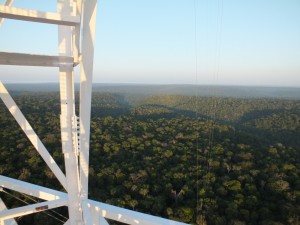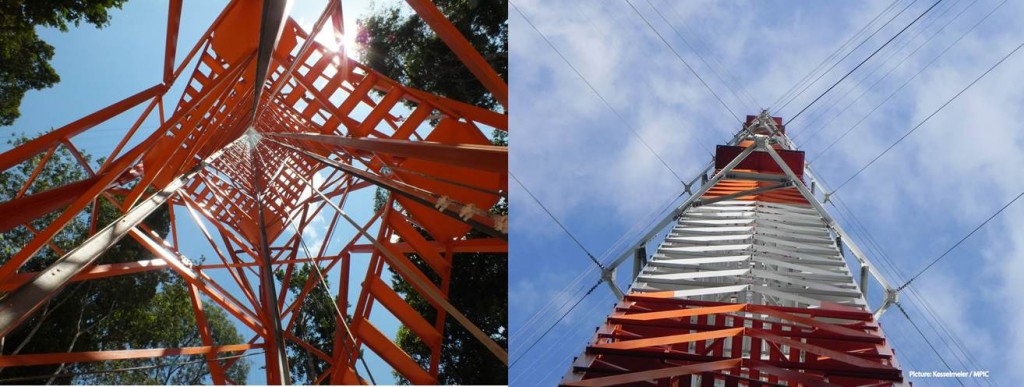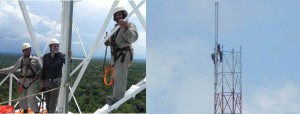
“The outcome of this project will help us to understand the Amazonian forest system before we all destroy it completely”
The Amazon Rainforest in South America represents the Earth´s largest rainforest, housing at least 10% of the world´s known biodiversity and consisting of more than 350 billion individual trees. Besides its large diversity in floral and faunal species, the Amazonian biome has an important impact on the global atmosphere. It produces half of the global atmospheric oxygen via photosynthesis and evaporates vast amounts of water into the atmosphere influencing the climate worldwide. Nevertheless, this unique biome is under constant human threat as deforestation has continued in the last decades and only begun to dwindle since 2004.
There is a need to better understand the key roles the Amazon biome plays on a local, regional, and global scale. To do this a German-Brazilian joint project was initiated in 2008 and coordinated by the Max Planck Institute for Chemistry, the Max Planck Institute for Biogeochemistry, the Brazilian National Institute of Amazonian Research, Instituto Nacional de Pesquisas da Amazônia (INPA), and the University of the State of Amazonas and the Universidade do Estado do Amazonas(UEA). The core of the project was to build the Amazonian Tall Tower Observatory (ATTO) right in the heart of the Amazonian rainforest. Thereby allowing researchers to measure greenhouse (e.g. CO2 , CH4, and N2O) and trace gases along with volatile organic compounds and ozone (for understanding aerosol formation) far away from anthropogenic influences. Moreover, they will use the tower-based measurements to assess turbulence and transport processes up to the lower atmospheric boundary layer and to validate and develop different type of models on vegetation, atmospheric boundary layer processes and ecosystem-atmosphere gas exchange. During a short interview for this blog post Jürgen Kesselmeier, from the Max-Planck-Institute for Chemistry in Mainz and the German coordinator of the project, said “Data from the ATTO project will reflect biosphere/atmosphere exchange and effects on cloud development over a forested area related to a transport distance of several hundred kilometers.” While tall towers, such as the the 302 m high Zotino Tall tower observatory (ZOTTO) in the Siberian Taiga, have been used in the past for greenhouse gas and aerosol monitoring before, this project aimed to erect one of the highest towers in one of the most ecologically important terrestrial biomes of the world.

Morning view from the ATTO tower over the Amazonian rainforest (credit: Susanne Benner/Max Planck Institute for Chemistry).

Reaching 325 meters into the sky above the Amazonian rainforest, the ATTO is the tallest tower in South America even taller than the Eiffel Tower. Photo on the left shows the tower base (credit: Susanne Benner, Max Planck Institute for Chemistry). Photo on the right shows the tower top (credit: Jürgen Kesselmeier/ Max Planck Institute for Chemistry).
A site was selected 150 km northeast of Manaus, Brazil (see map), at Sebastiao do Uatuma in Amazonas state, to allow for measurements with minimal human perturbation in a location with easy accessibility to facilitate research and educational activities. Construction of the 142 ton, 325m tall (331m with lightning rod) tower in the heart of the Amazonian rainforest, took 30 workers around 4 months to complete and was a logistical and constructional feat. A new road had to be build, allowing transport of the 15 000 tower components to the construction site. At the site, all the different tower elements had to be lifted and assembled using 24 000 screws and bolts and 26 km of steel cable was needed to safely anchor the tower to the rainforest ground. Meteorological and micrometeorological data at the site have been collected since 2012 using two 80m high towers. The 325m high tower was officially inaugurated last August and in the coming months the tower will be equipped with a wide array of instruments before the actual measurements will start by the end of 2016.

The location of the ATTO tower, 150 km northeast of Manaus, Brazil at Sebastiao do Uatuma in Amazonas state and right in the heart of the Amazonian rainforest (credit: Andreae et al. 2015, Atm. Chem. Phys.)
Finally, an important question is whether data from the ATTO tower can help to convince policymakers to stop deforestation of the Amazonian rainforest. “As the outcome of the ATTO project will highlight the role of the Amazonian rainforest in the relationship between global change, carbon cycle, trace gasses and aerosols and clouds, it will make the needs of this biome visible and strongly support its protection, ” says Jürgen Kesselmeier. In short, the outcome of this project will help us to understand the Amazonian forest system before we all destroy it completely. The ATTO project already attracted the interests of the media and in the future, all scientists involved in the project will start disseminating their results. Therefore, it can be expected that in the coming years, we´ll hear much more about this scientific sky-scraper and its role in saving the planet´s green lungs.

Construction of the 325m tall ATTO tower was not for the faint-hearted. In the picture on the left, taken at 130m height, you can see Jürgen Kesselmeier from the Max-Planck Insitute of Chemistry, Mainz and German coordinator of the ATTO project together with two construction workers. On the right you can see construction workers assembling the tower at 150m height (credit: Jürgen Kesselmeier, Max Planck Institute for Chemistry).
References:
Andreae et al. (2015) The Amazon Tall Tower Observatory (ATTO): overview of pilot measurements on ecosystem ecology, meteorology, trace gases, and aerosols. Atmos. Chem. Phys., 15, 10723-10776
For more information on the project and an impressive movie of the construction, visit:
http://www.mpic.de/en/research/collaborative-projects/atto.html
For an overview of the different type of measurements performed during the ATTO project, visit:
http://infograficos.estadao.com.br/public/cidades/torre-amazonia/atto/
